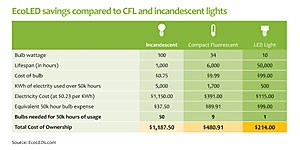Local company to show off energy-efficient lighting on UA Mall today
Energy is continually getting more expensive. One company, EcoLEDs, is pursuing the idea of a longer-lasting, more efficient light bulb that uses only a tenth of the energy of incandescent bulbs.
EcoLEDs is a Tucson-based company that makes, as its name suggests, LED lights. LEDs, or light-emitting diodes, emit light when an electric current passes through them, and are often used as indicator lights because they do not grow very hot when they function, as incandescent lights do. Unlike fluorescent lights, they do not have mercury or other toxic substances in them, making them safer overall, said Steve Diaz, EcoLEDs media relations spokesman.
EcoLEDs will be on display on the UA Mall today in recognition of the UA’s Sustainability Week, said Mike Adams, founder of EcoLEDs and an entrepreneur who previously ran a software company.
EcoLED will
LEDs can last up to 50,000 hours and are much more efficient than incandescent bulbs.
be “”raising awareness”” about its company along with other companies that will be promoting products and methods in support of a “”green”” lifestyle, he said.
There have been some difficulties with making LEDs practical for consumers. One of the biggest issues EcoLEDs solved was making the LEDs compatible with an 110-bolt socket, the most common socket type in residential homes, Diaz said.
Prior to this development, large LEDs were used mainly in commercial and government areas, he added.
At an alternative energy expo held by the Pima Association of Governments last month, Diaz said the idea of using LEDs in the home was very popular.
“”The public are the first to embrace them,”” he said, adding that LEDs can last up to 50,000 hours and are much more
efficient than incandescent bulbs.
However, they are also more expensive, costing about $100 for a 10-watt bulb versus about 50 cents for an incandescent bulb that uses 100 watts to achieve the same brightness, Diaz said. He added that incandescent bulbs expend the most energy to produce heat rather than visible light.
Diaz believes LED bulbs offer “”very significant savings”” over the long term, looking at both replacement costs and the cost of energy needed for the light source.
Adams, who founded EcoLEDs in April, said he considers the company a way to “”evangelize”” the benefits of using LEDs. He expects their use will take off within the next five to 10 years, once companies like General Electric start to market them.
This will happen as the price for the LEDs drop, he said.
“”There’s a potential 25-percent price drop per year,”” Adams said. The components for the LED will become less expensive, he added, although some of the material needed for the bulbs, like copper, will remain expensive.
“”I’m excited to show people something different,”” Adams said. “”I hope to make it mainstream.””









